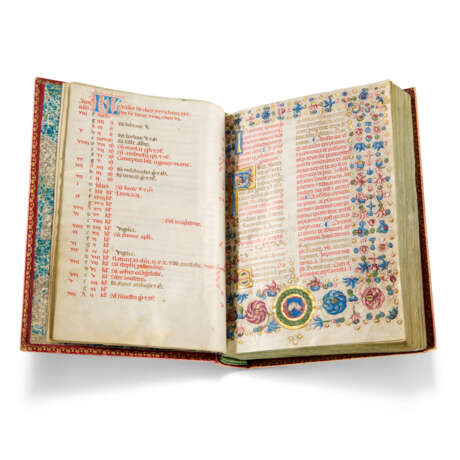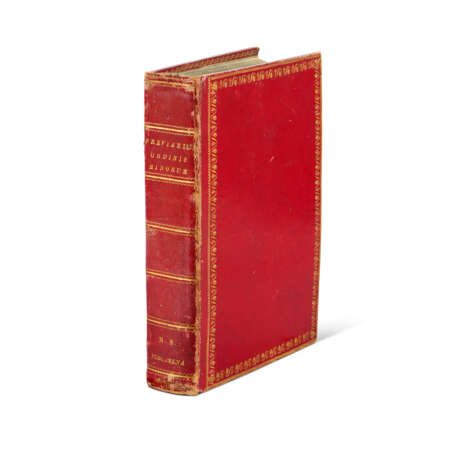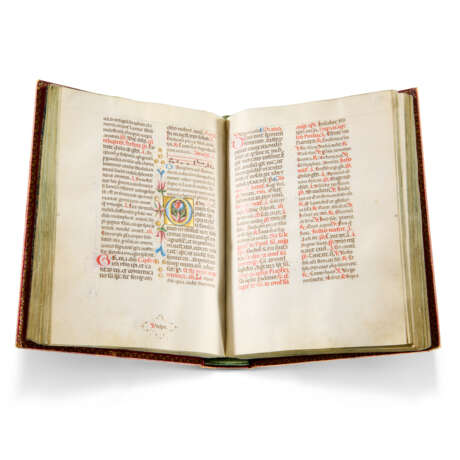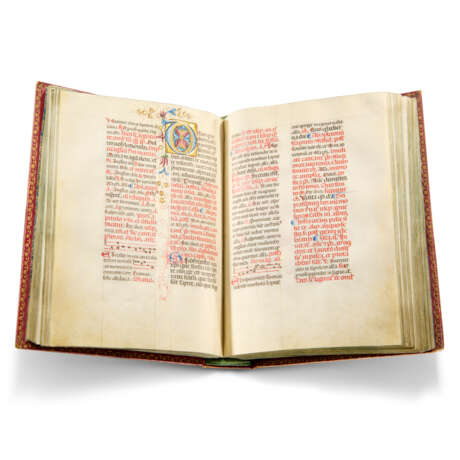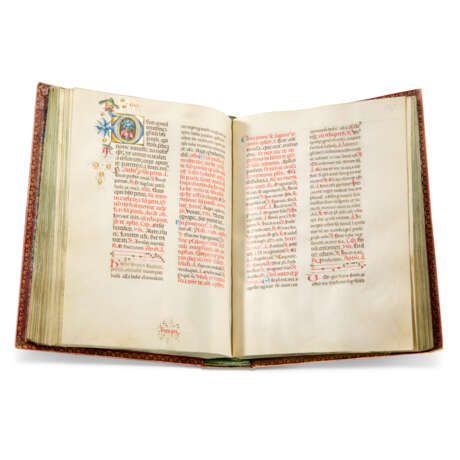ID 1249816
Lot 36 | Leonardo Bellini (active 1443–90)
Valeur estimée
£ 30 000 – 50 000
Noted Breviary, Franciscan use, in Latin, illuminated manuscript on vellum [north-eastern Italy, probably Venice, c.1472–81]
A Franciscan Breviary illuminated by Leonardo Bellini.
c. 260 × 190mm. ii (paper) + I + 211 + ii (paper) leaves, complete, collation: 16, 2–1910, 208, 2110, 227 (of 8, viii cancelled), catchwords in ornamental cartouches, a few leaf signatures (f–l, gatherings 7–12), ff.208–211 ruled, otherwise originally blank, ruled in ink, c. 170 × 120mm, written in two columns of 28 lines in several sizes of a rounded gothic script, rubrics in red, many pages with music in square notation on 4-line red staves, 2-line initials throughout alternately red or blue with penwork in purple or red, illuminated with thirty-nine large foliate initials, the first page of the main text with a full illuminated border of lush coloured flowers and leaves with burnished gold bezants infilled with penwork in the Ferrarese style and shield in wreath and gold frame (slight rubbing to outer edge of the border, a few minor stains and signs of use, a few early additions in a humanistic hand, generally in very fine condition), bound in straight-grained red morocco c. 1800, the covers framed by a gilt roll of a wavy line and palmettes, the spine lettered in gilt capitals "Breviarium / Ordinis / Minorum" and "M.S. / Pergamena", marbled endleaves, paper flyleaves, blue edges (slightly scuffed and the corners worn)
Provenance:
(1) Made for Franciscan Use, probably between 1472 and 1481: the first rubric states ‘Incipit ordo breviarii fratrum minorum’; the arms on f.7r are those of the Franciscan order; the calendar has numerous highly-graded Franciscan feasts (e.g. ‘Translatio sancti Antonii [of Padua] de ordine fratrum minorum, duplex’, 15 February; ‘Translatio sancti francisci, duplex maius’, 25 May; ‘Festum impressionis sacrorum stigmatum beati Francisci, duplex’, 17 September); and some feasts allow the writing to be dated: of the three feasts of San Bernardino, his translation (17 May, ‘duplex minus’), his death (‘Sancti Bernardini confessoris ordinis minorum, duplex maius’, 20 May), and its octave (27 May, ‘duplex’), the first of these was instituted in 1472; early additions include the feasts of the Five Franciscan Martyrs (16 January) and of St. Bonaventura (8 July, ‘duplex maius’), instituted in 1481 and 1482.
(2) Edward Hailstone (1818–1890), Yorkshire solicitor and book collector: with offsets of his circular gilt leather bookplate; his sale at Sotheby’s, 23 April 1891 and seven following days, lot 687, bought for £5 by Ridler, with a clipping from one of his(?) catalogues stuck to the front pastedown, in which this was no. 10, recording that it had been priced 30 guineas in 1870.
(3) Sold at Sotheby’s, 9 July 1973, lot 58, to Quaritch.
(4) Sam Fogg Rare Books, Catalogue 14: Medieval Manuscripts, catalogue by Kay Sutton (London, 1991), no. 23 (col. ill.).
(5) Heribert Tenschert, Katalog XXXI: Leuchtendes Mittelalter VI: 44 Manuskripte vom 14. bis zum frühen 17. Jahrhundert, catalogue by Eberhard König (Ramsen, 1993), no 50.
Content:
Calendar, f.1; Temporale, from the first Saturday in Advent, f.7, with a Litany before Lent, f.48, including Sts Francis, Anthony, Dominic, and Clare, the fifth of the following collects for the Minister General of the Order (‘famulo tuo ministro nostro’, f.50v); Sanctorale, f.105, from the feast of St Saturninus (29 November) to St Catherine (25 November); Common of Saints, f.147v, and Dedication of a Church; Offices of the Virgin, f.158, of the Dead, f. 167v, and for the Visitation of the Sick, f.178r, for Communion of the Dying, f.180v, the Commendation of Souls, f.181v, beginning with a short Litany, followed by the Burial Service, with instructions for preparing the body, etc.; blessings before and after meals, f.190v; commemorations for Franciscan saints, f.193v; ruled, otherwise blank, f.194v; Hymns, f.195r; followed, ff.207v–208, by an added copy of a papal bull concerning Corpus Christi and other feasts.
Illumination:
The illumination has been attributed by Kay Sutton to Leonardo Bellini (fl. 1443–90), ‘the most important Venetian illuminator of the period 1455–75’ (Giordana Mariani Canova, La miniatura veneta dal Rinascimento, Venice, 1969, p. 22; on whom see also Susy Marcon, in Dizionario biografico dei miniatori italiani: secoli IX–XVI, ed. by M. Bollati (Milan, 2004), pp. 76–78). His career can be traced with some accuracy thanks to documents and several dated works. He was apprenticed to his uncle, the famous painter Jacopo Bellini, for two years from 1443. His manuscripts include a Bible, of 1461 (Padua, Biblioteca Seminario, MS XXI), the documented Promissio of Niccolo Marcello of 1473 (Venice, Biblioteca Correr, MS. III,322), the Mariegola of the Scuola dei Mascoli, of 1476 (Venice, Museo Diocesano S. Apollonia, no. 32), and the unfinished Tacuinum sanitatis, of 1490 (Vienna, ÖNB, Vindoboniensis 2396). While fundamentally Venetian, his style usually includes the Ferrara-derived brown ink lacework in the borders.
| Lieu d'origine: | Italie, Europe |
|---|---|
| Catégorie maison de vente aux enchères: | Manuscrits médiévaux et de la Renaissance, Livres et manuscrits |
| Lieu d'origine: | Italie, Europe |
|---|---|
| Catégorie maison de vente aux enchères: | Manuscrits médiévaux et de la Renaissance, Livres et manuscrits |
| Adresse de l'enchère |
CHRISTIE'S 8 King Street, St. James's SW1Y 6QT London Royaume-Uni | |
|---|---|---|
| Aperçu |
| |
| Téléphone | +44 (0)20 7839 9060 | |
| Commission | see on Website | |
| Conditions d'utilisation | Conditions d'utilisation |
